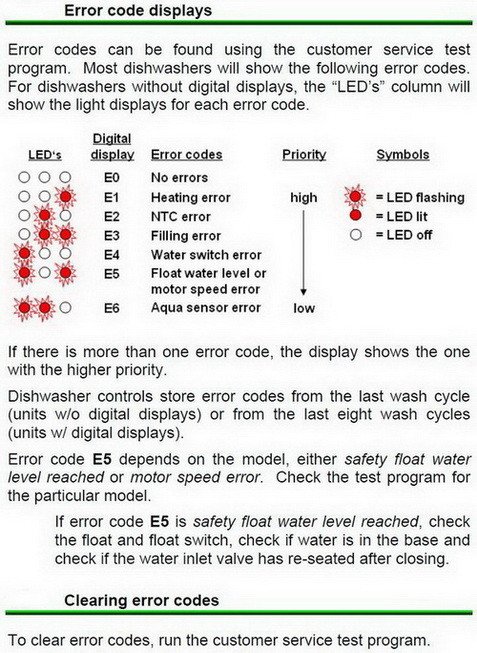
Imagine your Bosch dishwasher as a finely tuned orchestra. Every part, from the water inlet valve to the drain pump, plays a crucial role in the symphony of cleaning your dishes. When one instrument hits a sour note, in this case, displaying an E1 error code, it means something is off-key. This error usually indicates a problem with the water supply — like a drum that’s not getting enough water to create the right sound. But here’s the deal: sometimes a simple reset can get your dishwasher back on track, much like re-tuning an instrument. Before diving into technical repairs or calling a professional, let’s explore whether a reset could be your quick fix.
Understanding the E1 Error Code in Bosch Dishwashers
To understand what to do about the E1 error code, it’s essential to know what it signifies. In Bosch dishwashers, the E1 error code typically relates to a water supply issue. Think of it like trying to fill a watering can without water running through the hose. It’s frustrating, right? This could mean not enough water is reaching the dishwasher, or maybe there’s a blockage or kink in the hose preventing water from flowing freely.
So why does this happen? Sometimes, the water line might be bent or obstructed, preventing water from reaching the appliance effectively. In other cases, it could be due to low water pressure from your home’s plumbing. If you’ve recently installed new plumbing fixtures or made changes to your water supply, this could also trigger the E1 error code.
Now, what can you do to solve this? Before rushing into any conclusions or repairs, it’s worthwhile to check the water supply to your dishwasher. Ensure that the hose is straight and free from any bends or kinks. Also, verify that the water valve is fully open to allow maximum water flow. By addressing these potential issues, you might just solve the problem without needing to move on to more complex solutions.
Can Resetting the Dishwasher Solve the E1 Error?
You might be wondering if a simple reset can actually fix an E1 error code. Well, think of your dishwasher’s reset function as hitting the ‘refresh’ button on a glitchy computer. Sometimes, a reset can clear minor electronic hiccups that cause error codes to appear. It’s a quick and easy first step before diving into more involved troubleshooting.
To reset your Bosch dishwasher, you typically start by holding the Start button for about 3 to 5 seconds. This action prompts the machine to cancel the current cycle and reboot its system. During this process, the dishwasher might drain any water currently in the system and reset its programs. After allowing the reset process to complete, start a new cycle and see if the E1 error code reappears.
If the E1 code vanishes after the reset, congratulations! You’ve just saved yourself some hassle and potentially, a repair bill. However, if it persists, this could mean that the issue is more than just a minor glitch in the system. In such cases, it might be time to explore other troubleshooting steps or even reach out to a professional for help.
Alternatives to Resetting Your Bosch Dishwasher
If resetting doesn’t resolve the E1 error, don’t worry — there are other steps you can take. Start by revisiting the water supply issues mentioned earlier. Make sure the water inlet valve is working correctly and that your home’s water pressure is adequate. A faulty valve is like a clogged faucet, and no matter how many times you reset, if water can’t flow properly, the dishwasher won’t function as it should.
Another common cause could be a malfunctioning flow meter or a blocked filter. These components ensure that the right amount of water enters the dishwasher at the right time. If either is faulty or clogged, it can trigger the E1 error. Cleaning the filter and inspecting the flow meter for blockages could help resolve the problem.
Finally, if you’ve tried everything and the error persists, it might be time to consult the experts. Sometimes, internal issues such as a defective pressure switch or wiring problems can cause persistent error codes. In such cases, having a professional diagnose and fix the issue is the best course of action. They have the tools and expertise to delve deeper into the appliance’s mechanics and ensure everything is operating smoothly.
Keeping Your Bosch Dishwasher in Top Shape
Prevention, as they say, is better than cure. Regular maintenance can help keep your Bosch dishwasher in peak condition and reduce the likelihood of encountering the E1 error in the future. Routinely checking and cleaning the filters, ensuring water supply lines are free from obstruction, and occasionally running a cleaning cycle with a dishwasher cleaner can make a big difference.
Developing a habit of inspecting your appliance occasionally can prevent small issues from blowing up into significant problems. For instance, address any unusual noises or changes in how your dishwasher runs — these could be early signs of an underlying issue. By staying ahead of potential problems, you’re more likely to enjoy trouble-free dishwashing and prolong the lifespan of your appliance.
In conclusion, while resetting your Bosch dishwasher can sometimes fix an E1 error code, it’s not always the solution. By understanding the potential causes and exploring both simple and complex solutions, you’re better equipped to tackle this issue head-on. And remember, maintaining your appliance through regular checks and cleaning can help avoid future hiccups.